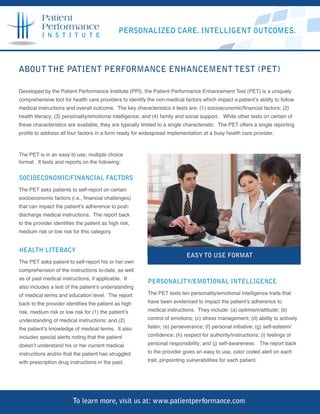About the pet
- 1. Patient Performance PERSONALIZED CARE. INTELLIGENT OUTCOMES. I N S T I T U T E ABOUT THE PATIENT PERFORMANCE ENHANCEMENT TEST (PET) Developed by the Patient Performance Institute (PPI), the Patient Performance Enhancement Test (PET) is a uniquely comprehensive tool for health care providers to identify the non-medical factors which impact a patientâs ability to follow medical instructions and overall outcome. The key characteristics it tests are: (1) socioeconomic/financial factors; (2) health literacy; (3) personality/emotional intelligence; and (4) family and social support. While other tests on certain of these characteristics are available, they are typically limited to a single characteristic. The PET offers a single reporting profile to address all four factors in a form ready for widespread implementation at a busy health care provider. The PET is in an easy to use, multiple choice format. It tests and reports on the following: SOCIOECONOMIC/FINANCIAL FACTORS The PET asks patients to self-report on certain socioeconomic factors (i.e., financial challenges) that can impact the patientâs adherence to post- discharge medical instructions. The report back to the provider identifies the patient as high risk, medium risk or low risk for this category. HEALTH LITERACY EASY TO USE FORMAT The PET asks patient to self-report his or her own comprehension of the instructions to-date, as well as of past medical instructions, if applicable. It PERSONALITY/EMOTIONAL INTELLIGENCE also includes a test of the patientâs understanding of medical terms and education level. The report The PET tests ten personality/emotional intelligence traits that back to the provider identifies the patient as high have been evidenced to impact the patientâs adherence to risk, medium risk or low risk for (1) the patientâs medical instructions. They include: (a) optimism/attitude; (b) understanding of medical instructions; and (2) control of emotions; (c) stress management; (d) ability to actively the patientâs knowledge of medical terms. It also listen; (e) perseverance; (f) personal initiative; (g) self-esteem/ includes special alerts noting that the patient confidence; (h) respect for authority/instructions; (i) feelings of doesnât understand his or her current medical personal responsibility; and (j) self-awareness. The report back instructions and/or that the patient has struggled to the provider gives an easy to use, color coded alert on each with prescription drug instructions in the past. trait, pinpointing vulnerabilities for each patient. To learn more, visit us at: www.patientperformance.com
- 2. Patient Performance PERSONALIZED CARE. INTELLIGENT OUTCOMES. I N S T I T U T E FAMILY AND SOCIAL SUPPORT The PET requests that the patient self-report on the level of both logistical and emotional support from his or her friends and family. The report back to the provider identifies the patient as high, medium or low risk in each of the logistical support and the emotional support factors. Special alerts also identify to the provider if the patient has transportation challenges (logistical support) and if the patient self-reports as preferring to solve challenges without asking friends or family members (emotional support), so that the solutions can be developed accordingly. IDENTIFY PATIENTâS NON-CLINICAL NEEDS Fewer than 60 questions, the PET can be completed in as little as fifteen minutes, though it may take longer for some patients. Ideally, the patient self-administers the questionnaire, but in settings where the patient is unable to do so, a nurse, social worker or other professional can ask the patient the questions and record the answers. Once the patient takes the test, PPI provides electronic results identifying vulnerabilities swiftly back to the provider, which is then able to use focused interventions before and after the patient is sent home. A copy of the results can live in the patientâs medical record, and be shared with his or her other physicians, nurses and other practitioners. This easy-to-use, one of a kind tool provides unique insights into each patient, allowing the use of customized solutions to address those personal traits which will impact the patientâs ability to care successfully for himself or herself. Health care providers now have a missing piece of the puzzle to complete the push to improve outcomes in todayâs health care industry. To learn more, visit us at: www.patientperformance.com


